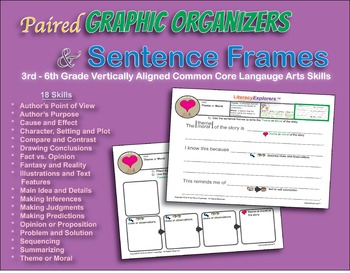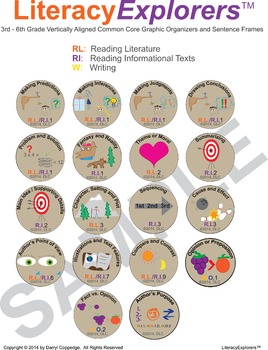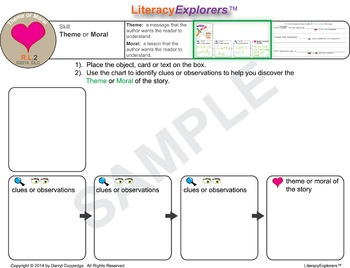Paired Graphic Organizers & Sentence Frames
Darryl Coppedge
35 Followers
Grade Levels
3rd - 7th
Resource Type
Standards
CCSSRL.3.1
CCSSRL.3.2
CCSSRL.3.6
CCSSRL.3.7
CCSSRL.3.9
Formats Included
- PDF
Pages
36 pages
Darryl Coppedge
35 Followers
Description
• 3rd - 7th grade vertically aligned Common Core Language Arts skills.
• Engaging and highly effective scaffolding tools.
• Addresses 3 domains: Reading Literature, Reading Informational Texts and Writing.
• Covers 18 skills including: Author's Point of View, Author's Purpose, Cause and Effect, Character, Setting and Plot, Compare and Contrast, Drawing Conclusions, Fact vs. Opinion, Fantasy and Reality, Illustrations and Text Features, Main Idea and Details, Making Inferences, Making Judgements, Making Predictions, Opinion or Proposition, Problem and Solution, Sequencing, Summarizing, and Theme or Moral.
• Includes 35 paired graphic organizers and sentence frames.
• These same graphic organizers and sentence frames are key components that have allowed my Title I 3rd grade class to excel in the following ways:
• Surpassed year-end Third Grade Reading goal of 90% of students will achieve a Student Growth Percentile (SGP) of +35, currently with an exceeding mark of 96% of my students have achieved an SGP of +35 with a class median of +80 attained within a 10 month school year (STAR National Assessment, June 2016).
• Class median SGP in Reading (on scale of 0-99) exceeds +14 School, +22 District, +31 Nation (STAR, June 2016).
• Increased Third Grade class average Grade Equivalency (GE) in Reading from 2nd grade, 6 months to 4th Grade, 3 months. This is 1 year, 7 months of average growth within 10 months of school (STAR, June 2016).
• Engaging and highly effective scaffolding tools.
• Addresses 3 domains: Reading Literature, Reading Informational Texts and Writing.
• Covers 18 skills including: Author's Point of View, Author's Purpose, Cause and Effect, Character, Setting and Plot, Compare and Contrast, Drawing Conclusions, Fact vs. Opinion, Fantasy and Reality, Illustrations and Text Features, Main Idea and Details, Making Inferences, Making Judgements, Making Predictions, Opinion or Proposition, Problem and Solution, Sequencing, Summarizing, and Theme or Moral.
• Includes 35 paired graphic organizers and sentence frames.
• These same graphic organizers and sentence frames are key components that have allowed my Title I 3rd grade class to excel in the following ways:
• Surpassed year-end Third Grade Reading goal of 90% of students will achieve a Student Growth Percentile (SGP) of +35, currently with an exceeding mark of 96% of my students have achieved an SGP of +35 with a class median of +80 attained within a 10 month school year (STAR National Assessment, June 2016).
• Class median SGP in Reading (on scale of 0-99) exceeds +14 School, +22 District, +31 Nation (STAR, June 2016).
• Increased Third Grade class average Grade Equivalency (GE) in Reading from 2nd grade, 6 months to 4th Grade, 3 months. This is 1 year, 7 months of average growth within 10 months of school (STAR, June 2016).
Total Pages
36 pages
Answer Key
N/A
Teaching Duration
N/A
Report this resource to TPT
Reported resources will be reviewed by our team. Report this resource to let us know if this resource violates TPT’s content guidelines.
Standards
to see state-specific standards (only available in the US).
CCSSRL.3.1
Ask and answer questions to demonstrate understanding of a text, referring explicitly to the text as the basis for the answers.
CCSSRL.3.2
Recount stories, including fables, folktales, and myths from diverse cultures; determine the central message, lesson, or moral and explain how it is conveyed through key details in the text.
CCSSRL.3.6
Distinguish their own point of view from that of the narrator or those of the characters.
CCSSRL.3.7
Explain how specific aspects of a text’s illustrations contribute to what is conveyed by the words in a story (e.g., create mood, emphasize aspects of a character or setting).
CCSSRL.3.9
Compare and contrast the themes, settings, and plots of stories written by the same author about the same or similar characters (e.g., in books from a series).





